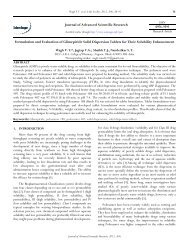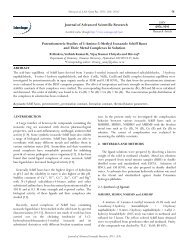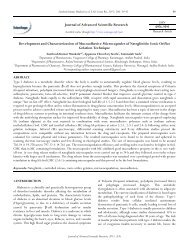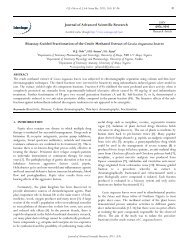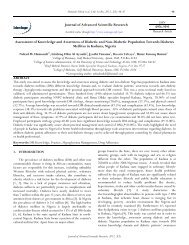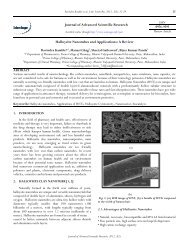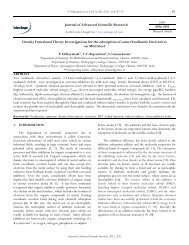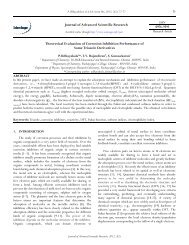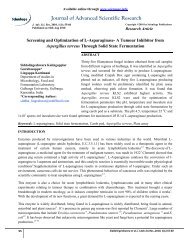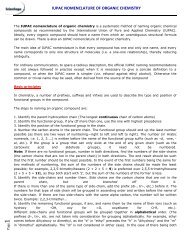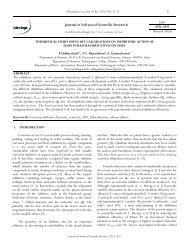analysis of effluents released from recycled paper ... - Sciensage.info
analysis of effluents released from recycled paper ... - Sciensage.info
analysis of effluents released from recycled paper ... - Sciensage.info
Create successful ePaper yourself
Turn your PDF publications into a flip-book with our unique Google optimized e-Paper software.
Raaz Maheshwari et al, J Adv Scient Res, 2012, 3(1): 82-85 82<br />
Journal <strong>of</strong> Advanced Scientific Research<br />
Available online through http://www.sciensage.<strong>info</strong>/jasr<br />
ISSN<br />
0976-9595<br />
Research Article<br />
ANALYSIS OF EFFLUENTS RELEASED FROM RECYCLED PAPER INDUSTRY<br />
Raaz Maheshwari* 1 , Bina Rani 2 , Archana Saxena 3 , Magan Prasad 4 , Upma Singh 5<br />
1 Department <strong>of</strong> Chemistry, SBRMGC, Nagaur, Rajasthan<br />
2 Department <strong>of</strong> Engineering Chemistry & Environmental Engineering, PCE, Sitapura, Jaipur, Rajasthan<br />
3 Department <strong>of</strong> Engineering Chemistry & Environmental Engineering, SKIT, Jagatpura, Jaipur, Rajasthan<br />
4 Department <strong>of</strong> Chemistry MSJC, Bharatpur, Rajasthan<br />
5 School <strong>of</strong> Vocational Studies & Applied Sciences, GBU, Greater Noida, UP<br />
*Corresponding author: binaraj_2005@rediffmail.com<br />
ABSTRACT<br />
Waste Water and nearby soil samples <strong>of</strong> <strong>recycled</strong> <strong>paper</strong> industry are collected <strong>from</strong> Northern districts <strong>of</strong> UP viz. Saharanpur,<br />
Muzaffarnagar & Meerut and analyzed for various parameters like pH, TDS, TVS, TSS, TFS, TRC, TS, BOD, COD, Chloride, DO.<br />
The inferences were drawn on the basis <strong>of</strong> <strong>analysis</strong>. The very high absorbance in the region 200-300nm value suggests that these<br />
<strong>effluents</strong> are not fit to be disposed to the water stream as these <strong>effluents</strong> will result in increase <strong>of</strong> organic load in water streams. The<br />
present manuscript reports the investigation <strong>of</strong> the characteristics <strong>of</strong> <strong>effluents</strong> <strong>released</strong> <strong>from</strong> <strong>recycled</strong> <strong>paper</strong> mills <strong>of</strong> UP state to<br />
access the pollution load <strong>of</strong> recycling <strong>paper</strong> mills on the environment.<br />
Keywords: Bioaccumulation, COD, TOC, Ozonation, Photochemical processes, Electrochemical processes.<br />
1. INTRODUCTION<br />
Recycled Paper industry is a globally growing industry that<br />
consumes a significant amount <strong>of</strong> resources, raw materials and<br />
energy. The characteristics <strong>of</strong> the wastewaters generated <strong>from</strong><br />
various processes <strong>of</strong> the <strong>recycled</strong> pulp and <strong>paper</strong> industry<br />
depends upon the types <strong>of</strong> processes and raw materials,<br />
process/ technology applied, management practices, internal<br />
recirculation <strong>of</strong> the <strong>effluents</strong> for recovery and the amount <strong>of</strong><br />
water being used in a particular process. The majority <strong>of</strong><br />
pollutants <strong>released</strong> in pulp and <strong>paper</strong> industry originate <strong>from</strong><br />
the pulping and bleaching stages. The high organic content <strong>of</strong><br />
pulping wastewater, coupled with the presence <strong>of</strong> chlorine,<br />
results in the production <strong>of</strong> highly toxic organic compounds<br />
[1]. Chlorinated phenols, guaiacols, catechols, furans, dioxins,<br />
aliphatic hydrocarbons, etc. are <strong>of</strong> prime concern. Some<br />
members <strong>of</strong> this family are known to be toxic, mutagenic,<br />
persistent, and bio-accumulating and are thought to cause<br />
numerous harmful disturbances in biological systems, and pose<br />
a human risk through long-term exposure via drinking water<br />
and through bioaccumulation along with food chain [2, 3].<br />
End-<strong>of</strong>-pipe treatment <strong>of</strong> wastewaters can be accomplished<br />
by integration <strong>of</strong> traditional biological treatment processes with<br />
chemical.<br />
Advanced oxidation applications & chemical oxidation<br />
technologies have revealed that the applied processes are<br />
effective and promising applications for the treatment <strong>of</strong> pulp<br />
and <strong>paper</strong> industry wastewaters [4, 5]. Ozonization is efficient<br />
in removing COD, TOC, color and increasing the<br />
biodegradability <strong>of</strong> the wastewater in many cases [6, 7].<br />
However, it is an expensive process. Electrochemical methods<br />
have proved to be an efficient treatment option for the<br />
treatment <strong>of</strong> pulp and <strong>paper</strong> industry wastewaters.<br />
Combinations <strong>of</strong> two or more physicochemical processes can<br />
be used for the enhancement <strong>of</strong> removal efficiencies and design<br />
<strong>of</strong> the setup [8]. Currently no relevant data is available on the<br />
states/ parameters <strong>of</strong> the <strong>effluents</strong> <strong>released</strong> <strong>from</strong> <strong>recycled</strong><br />
<strong>paper</strong> mills; the most important task seems to be the<br />
assessment <strong>of</strong> the <strong>effluents</strong> <strong>of</strong> <strong>recycled</strong> <strong>paper</strong> mills so as to<br />
design the specific treatment systems for the recycling mills.<br />
The demand for the <strong>paper</strong> and <strong>paper</strong>board by the year<br />
2006-2007 in India was 3.8 million tons/annum and 4.9<br />
million tons per annum at the end <strong>of</strong> the year 2010. India was<br />
also the first country in the world to use bamboo as a basic raw<br />
material for making <strong>paper</strong>. Due to limited forest resources,<br />
other raw materials like bagasse, straw, jute, etc. were<br />
identified and are now extensively used in the <strong>paper</strong> products.<br />
Waste <strong>paper</strong> is also being widely used for <strong>paper</strong> making. At the<br />
same time pulp and <strong>paper</strong> industry is one <strong>of</strong> the largest and<br />
most polluting industries in the world. At present, there are<br />
Journal <strong>of</strong> Advanced Scientific Research, 2012, 3(1)
6666 pulp and <strong>paper</strong> mills in India, <strong>of</strong> which 632 units are<br />
agro-residue and <strong>recycled</strong> fibre based units (CPPRI, 2005).<br />
Being a fibre deficient country, two-third <strong>of</strong> the raw material<br />
comes <strong>from</strong> non-wood sources. These include agro-residues<br />
like rice straw, wheat straw, sarkanda, bagasse, jute rags as<br />
well as waste <strong>paper</strong>. To access the pollution load <strong>of</strong> recycling<br />
<strong>paper</strong> mills on the environment, the present manuscript<br />
reports the investigation <strong>of</strong> the characteristics <strong>of</strong> <strong>effluents</strong><br />
<strong>released</strong> <strong>from</strong> <strong>recycled</strong> <strong>paper</strong> mills <strong>of</strong> UP state.<br />
2. MATERIAL AND METHODS<br />
2.1. Collection <strong>of</strong> samples<br />
2.1.1. Effluent samples<br />
Raaz Maheshwari et al, J Adv Scient Res, 2012, 3(1): 82-85 83<br />
The high concentration <strong>of</strong> organic matter in the <strong>effluents</strong><br />
contributes to the Biochemical Oxygen demand (BOD) and<br />
depletion <strong>of</strong> dissolved oxygen in the receiving ecosystems. The<br />
organic compounds may be persistent, bio accumulative and<br />
toxic pollutants thereby removal <strong>of</strong> the <strong>effluents</strong> is desirable.<br />
Paper and pulp mill <strong>effluents</strong> are major contributor to<br />
absorbable organic halides (AOX) loads in the receiving<br />
ecosystems. Table 1 reflects that the treated effluent discharge<br />
<strong>of</strong> <strong>recycled</strong> <strong>paper</strong> mills contains high TDS (Total Dissolved<br />
Solids) and TSS (Total Suspended Solids). The high COD value<br />
reflects the presence <strong>of</strong> organic and inorganic matter which<br />
may be persistent and not degraded by the treatment process<br />
established at the industries. The physicochemical<br />
characteristics <strong>of</strong> <strong>effluents</strong> are shown in Table 1.<br />
The effluent samples were collected <strong>from</strong> the<br />
wastewater treatment plants <strong>of</strong> <strong>recycled</strong> <strong>paper</strong> mills <strong>of</strong><br />
Northern districts <strong>of</strong> UP viz. Saharanpur, Muzaffarnagar &<br />
Meerut. There were seven samples collected <strong>from</strong> various<br />
<strong>paper</strong> mills <strong>of</strong> these three districts. The effluent samples were<br />
24-hour composite samples collected in plastic bottles. All the<br />
samples were refrigerated at 4ºC. Prior to treatment; the<br />
samples were warmed to room temperature (24ºC to 27ºC).<br />
For UV Spectrophotometer <strong>analysis</strong>, the samples were<br />
centrifuged and again filtered through 0.45μm glass filters to<br />
remove suspended solids. Effluents samples collected <strong>from</strong><br />
<strong>recycled</strong> <strong>paper</strong> mills were analyzed for the required parameters<br />
in order to evaluate the pollution load <strong>of</strong> water streams in<br />
which they are thrown. The <strong>effluents</strong> were characterized by<br />
analyzing the physico-chemical characteristics.<br />
2.1.2. Soil Samples<br />
Organic and inorganic components <strong>of</strong> <strong>effluents</strong> enter<br />
into the soil and underground water and thus affecting the land<br />
and water streams. In order to assess the impact <strong>of</strong> wastes on<br />
the environment, the study has also been carried out for the<br />
<strong>analysis</strong> <strong>of</strong> the soil pr<strong>of</strong>ile near the <strong>recycled</strong> <strong>paper</strong> mills.<br />
Various samples were collected at variable distances (1, 2 and 5<br />
km) area <strong>from</strong> the <strong>recycled</strong> <strong>paper</strong> mills.<br />
Instruments used: These include UV Spectrophotometer<br />
(HACH: DR4000U), Water and Soil Analyzer kit (Model:<br />
GMK-731), COD Analyzer kit (Thermo Orion COD-<br />
125Meter), Centrifuge, Ultraviolet Lamp Unit, BOD5 days<br />
Incubator (HASH BOD Trak Incubator), Hot oven and Electric<br />
Furnace.<br />
3. RESULTS AND DISCUSSION<br />
3.1. Analysis <strong>of</strong> Effluent Samples<br />
The <strong>effluents</strong> generated by mills contain high<br />
concentration <strong>of</strong> chemicals in the receiving water bodies which<br />
results in reduced penetration <strong>of</strong> light, thereby affect habitat.<br />
3.2. Analysis <strong>of</strong> Soil Samples<br />
In order to assess the impact <strong>of</strong> wastes on the soil, the<br />
study has also been carried out for <strong>analysis</strong> <strong>of</strong> the soil pr<strong>of</strong>ile<br />
near the <strong>recycled</strong> <strong>paper</strong> mill. Various soil samples were<br />
collected at variable distances (1, 2 and 5 km) area <strong>from</strong> the<br />
<strong>recycled</strong> <strong>paper</strong> mills. The soil has high COD values which<br />
indicate the input <strong>of</strong> non biodegradable components in the soil,<br />
which decrease with increase in distance. The high COD value<br />
decreases the fertility <strong>of</strong> the soil and causes soil pollution and<br />
also has detrimental effect in the environment after long<br />
period. The pH <strong>of</strong> the soil decreases very near to the site i.e.,<br />
1km <strong>from</strong> <strong>paper</strong> mill, which indicates that the <strong>effluents</strong> are<br />
acidic in nature and hence affect the fertility <strong>of</strong> soil. pH varies<br />
<strong>from</strong> 6.72 to 8.14 with variation <strong>of</strong> distance <strong>from</strong> 1km to 5km,<br />
which is shown in the table 2.<br />
Decrease in pH near the mills was due to the acidic nature<br />
<strong>of</strong> <strong>effluents</strong>, which affect the pH <strong>of</strong> the soil. The DO in soil<br />
increases with increase in distance which show that the<br />
<strong>effluents</strong> contains chemical load which affect the DO value <strong>of</strong><br />
the soil and hence decreases the fertility <strong>of</strong> the soil and also<br />
affect the production and cause soil pollution.<br />
The DO value varies <strong>from</strong> 2.0ppm to 4.1ppm as the<br />
distance varies <strong>from</strong> 1km to 5km, which is shown in Table 2.<br />
The TDS value in soil decreases with increase in distance,<br />
which indicates that <strong>effluents</strong> contains big load <strong>of</strong> organic and<br />
inorganic components and non biodegradable components in<br />
the soil. The high TDS value <strong>of</strong> soil affects the fertility <strong>of</strong> the<br />
soil and cause soil pollution. The TDS values vary <strong>from</strong> 0.304<br />
ppm to 0.136ppm with the distance varying <strong>from</strong> 1km to 5km,<br />
which is shown in Table 2.<br />
Journal <strong>of</strong> Advanced Scientific Research, 2012, 3(1)
Raaz Maheshwari et al, J Adv Scient Res, 2012, 3(1): 82-85 84<br />
Table 1: Physicochemical Characteristics <strong>of</strong> Effluents <strong>from</strong> Recycled Paper Mills<br />
S No. Parameters S-1 S-2 S-3 S-4 S-5 S-6 S-7 Indian Standard<br />
(BIS)<br />
1 pH 6.79 7.05 7.37 6.94 7.25 7.38 7.62 5-9<br />
2 TDS 2300 2800 2700 3800 3100 3260 1760 2100<br />
3 TVS 1000 1500 400 1200 900 600 1000 -<br />
4 TSS 700 1500 1200 1400 1000 940 820 100<br />
5 TFS 3000 2800 3700 4000 3200 3600 2000 -<br />
6 TRC 3 4 3.5 5.8 6.2 5.3 4.6 1.00<br />
7 TS 4000 4300 4100 5200 4100 4200 3000 -<br />
8 BOD5 Day 192 188 126 152 132 168 124 30<br />
9 COD 1168 1120 518 1270 881 1276 961 150<br />
10 Chloride 505 448 349 647 363 508 576 600<br />
11 DO 0.4 0.6 1.5 0.6 0.7 0.9 2.0 5<br />
Except pH all parameters are in parts per million (ppm)<br />
Table 2: Parameters <strong>of</strong> Soil Samples at Different Distances<br />
S No. Parameters Soil (1km) Soil (2km) Soil (5km)<br />
1 Temperature (ºC) 14.6 14.6 14.6<br />
2 pH 6.72 8.02 8.14<br />
3 ORP(mV) 670 530 630<br />
4 DO(ppm) 2.0 3.4 4.1<br />
5 Conductivity (mS) 0.602 0.286 0.268<br />
6 TDS(ppt) 0.304 0.142 0.136<br />
7 Salinity(ppt) 000.3 000.2 000.2<br />
8 COD(ppm) 133 113 90<br />
3.3. UV-VIS Spectra <strong>of</strong> the <strong>effluents</strong><br />
The –Vis spectra <strong>of</strong> the effluent samples <strong>of</strong> <strong>recycled</strong> <strong>paper</strong><br />
mills were recorded and are given in figure 1. The UV-Vis<br />
spectra <strong>of</strong> the <strong>effluents</strong> show absorbance around 210nm, which<br />
indicated the presence <strong>of</strong> the aliphatic compounds with<br />
different functionalities as well as aromatic constituents. The<br />
most probable compounds present in the <strong>effluents</strong> stream may<br />
be phenol and its derivatives, liquor chlorophenols,<br />
chlorocatechols, etc. The maximum absorbance values (λmax)<br />
for all the samples have been recorded in Table 3. The very<br />
high absorbance in the region 200-300nm value suggests that<br />
these <strong>effluents</strong> are not fit to be disposed to the water stream as<br />
these <strong>effluents</strong> will result in increase <strong>of</strong> organic load in water<br />
streams. The UV-Vis spectra show the absence <strong>of</strong> any colored<br />
constituents present in the <strong>effluents</strong>.<br />
Sample No. Peak Value (λmax)<br />
Wavelength Absorbance<br />
1 211 2.893<br />
2 207 2.915<br />
3 205 2.717<br />
4 216 3.150<br />
5 208 2.898<br />
6 212 2.867<br />
7 206 2.982<br />
Table 3: λmax for the <strong>effluents</strong><br />
Fig. 1 Absorption Spectra <strong>of</strong> Effluents <strong>of</strong> Paper Mills<br />
4. CONCLUSION<br />
Treated industrial <strong>effluents</strong> <strong>released</strong> <strong>from</strong> <strong>recycled</strong> <strong>paper</strong><br />
mills have high COD (1270 ppm) and BOD (192ppm)<br />
contents. The UV-Vis spectra show the presence <strong>of</strong> organic<br />
compounds i.e, probably the chloro/ methoxy derivatives <strong>of</strong><br />
phenol. The soil samples <strong>from</strong> various distances <strong>from</strong> <strong>paper</strong><br />
mills are collected and analyzed, which showed that COD and<br />
TDS <strong>of</strong> <strong>effluents</strong> reduced with distance and pH and DO<br />
increased with increase in distance as we move away <strong>from</strong><br />
<strong>paper</strong> mills. The present study suggests incapability <strong>of</strong><br />
wastewater treatment plant to effectively remove many<br />
pollutants and it is not safe to dispose <strong>effluents</strong>in water strems<br />
or nearby fields.<br />
5. ACKNOWLEDGEMENT<br />
R&D Division MRD LifeSciences ( Sample Analysis Unit )<br />
B-3/46 & 47, 2nd Floor, Vibhuti Khand, Behind- Indus<br />
Towers, Gomti Nagar, Lucknow- 226 010 (UP)<br />
6. REFERENCES<br />
1. Miller RM, Singer GM, Rosen JD, Bartha R. Environmental<br />
Science and Technology, 1988; 22(10): 1215-1219.<br />
2. Legrini O, Oliveros E, Braun AM. Chemistry Review, 1993; 37:<br />
671-698.<br />
3. Carey JH. “An Introduction to AOPs for Destruction <strong>of</strong><br />
Organics in wastewater. In: Proceedings <strong>of</strong> the Symposium on<br />
Journal <strong>of</strong> Advanced Scientific Research, 2012, 3(1)
Oxidation Processes Treat. Contam. Water air, Wastewater Technol.<br />
Cent. Adv., Paper No.1, Burlington: Ontario; 1990.<br />
4. Beltrán F, González M, Alvarez P. Ingenieria Quimica, 1997; 331:<br />
161-168.<br />
5. Galze WH, Kang JW, Chapin DH. Ozone Science and Engineering,<br />
1987; 17: 335-352.<br />
6. Li L, Peishi C, Earnest F. AIChE J, 1991; 37: 1687-1697.<br />
Raaz Maheshwari et al, J Adv Scient Res, 2012, 3(1): 82-85 85<br />
7. Andreozzi R, Caprio V, Insola A, Martota R. Catalysis Today,<br />
1999; 53: 51-59.<br />
8. Benitez FJ, Beltran-Heredia J, Gonzalez T, Real F. Industrial<br />
Engineering Chemistry and Research, 1995; 34: 4099-4105<br />
9. Dass B, Suda D, Sharma S. Journal <strong>of</strong> Industrial Pollution Control,<br />
2011; 27(2): 185-189.<br />
10. Hoigne J, Bader H. Water Research, 1983; 17: 173-183.<br />
Journal <strong>of</strong> Advanced Scientific Research, 2012, 3(1)



